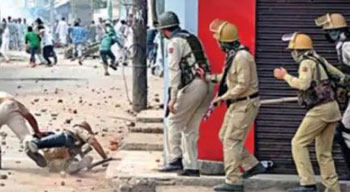A huge majority of those who received eye injuries due to gun pellets in Srinagar between July and November in 2016 have suffered some degree of vision loss, Times of India reported.
About 80% of them have vision limited to “counting fingers”, the newspaper quoted a review research paper on 777 eye operations carried out during this period.
The review strongly advised against the use of pellet guns on civilians. It said the injuries imposed a “significant physical, emotional, and socio-economic burden” on society and the patients (mostly males in the 20-29 age group) because of the poor vision, high cost of medical care and long-term rehabilitation.
One of the main authors of the paper, published in ‘The Indian Journal of Ophthalmology’, is Mumbai-based retina surgeon Dr S Natrajan. He had travelled to Srinagar five times in 2016 to operate on those injured by pellets, along with a doctor each from New Delhi and Chennai. Their visits came in the aftermath of the standoff between protestors, who were throwing stones, and the forces’ personnel who retaliated by shooting pellets.
Incidentally, most of the patients (98.7%) received surgical intervention on the day of admission or the very next day. The medical response was also “unique” in which the three surgeons managed more than 777 patients, conducted over 550 primary eye repairs, and performed over 370 vitreoretinal surgeries.
“In comparison, 797 cases of severe eye injuries were reported in the war in Iraq from 2003 to 2005, of which 116 eyes were removed. Report from the British armed forces in Iraq and Afghanistan showed a total of 63 cases of ocular injury from 2004 to 2008,” said the article.
Dr Natrajan told Times of India that he was contacted by a Pune-based NGO, Borderless World Foundation, to help the patients in Srinagar. “I gathered a team of two doctors who were equally willing to travel to Kashmir during such a precarious time: Syed Asghar Hussain of Optimus Maqbool Hospital in Chennai and Kenshuk Marwah from New Delhi,” he said.
In an editorial in the same journal, he wrote that they were apprised of the political strife, demonstrations, curfews and violence in Kashmir.
“All of it was laid bare in front of us. Despite it, we established our camp at SMHS Hospital in Srinagar. There, we found out that almost 210 cases with eye injuries caused by pellets were clamouring to receive treatment,” he added.—KMS










